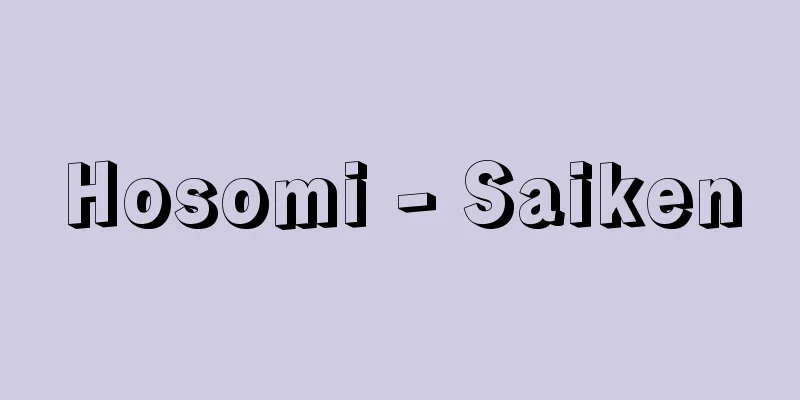Asamamono - Asamamono

|
A classification term for Japanese music. A type of Kabuki dance and accompanying Joruri. Based on a scene from the play "Keisei Asama-ga-take," which premiered in 1698 at the Yamashita-za in Kyoto and was performed again at the Yamamura-za in Edo, this is a general term for music that incorporates the idea of the incense used at the scene, in which a vow, a written oath, or other object is burned and the spirit of the lover appears from the smoke. Most are one-act dance music that became popular in Edo. The characters, objects burned, and plots vary depending on the piece. (1) Jiuta (Chinese folk song) “Asama.” A passage from the play mentioned above, in which the ghost of the prostitute Oshu is wooed. (2) Itchu-bushi "Yugasumi Asama-dake" (Yugasumi: Mount Asama) (abbreviated as "Yugasumi" or "Asama"). Composed by Hara Butayu. First performed at the Nakamuraza Theater in Edo in 1734 (Kyoho 19). (3) Icchu-bushi "Iezakura Keisei-zuta" (The Garden of Cherry Blossoms). The lyrics were by Tsuuchi Kyuheiji, and the music was by Miyako Senchu. It was first performed at the Nakamuraza Theater in 1736. (4) Bungo-bushi "Asaka Kagerou Sugata" (The Asaka Heat-roofed Gaze). Narrated by Miyakoji Bungo-no-jo. A part of the Gidayu-bushi "Keisei Hangonko" (The Incense Burning of a Spirit) by Chikamatsu Monzaemon. First performed in 1730 at the Onishi Theater in Osaka. (5) "The Asama-dake Sugata no Kisho" (The Icchu-bushi) First performed in 1744 at the Onishi Theater in Osaka. (6) Kawato-bushi "Koizakura Hangonko" (Koi Sakura Hangonko). The lyrics were by Nakamura Seizaburou, and the music was by Yamahiko Genshiro. It was first performed at the Nakamura Theater in the 1st year of the Horeki era (1751). (7) Tokiwazu-bushi "Tomesode Asama-dake" (Tomesode Asama-dake), lyrics by Ryosuke Namiki. First performed at the Ichimura Theater in Edo in 1764. (8) Tomimoto-bushi "Sono Omokage Asama-dake" (The Memory of Mount Asama) (abbreviated as "Asama"). Words by Kinpachi Masuyama, music by Tokuji Namizaki. First performed at the Ichimura Theater in 1779. (9) "Keisei Asama-dake" (The Fairy-Spear-Spring Mountain), with lyrics by Sakurada Jisuke I and music by Tobaya Satocho. First performed at the Nakamuraza Theater in 1892. (10) Tokiwazu-bushi "Hatsusakura Asama-dake" (First Cherry Blossoms at Mt. Asama), abbreviated as "Hatsusakura" (First Cherry Blossoms). Words by Kinpachi Masuyama, music by Koshikibu Kishizawa. First performed in 1797 at the Edo Miyakoza Theatre. (11) Kiyomoto-bushi "Hatsukasumi Asama-dake" ("Hatsuka"), abbreviated as "Hatsuka". Both the words and the music are borrowed from (8). First performed at the Ichimura Theatre in 1834. The dances for all of the above songs have been abolished, and the songs (4), (5), and (7) have also been abolished. Source: Encyclopaedia Britannica Concise Encyclopedia About Encyclopaedia Britannica Concise Encyclopedia Information |
|
邦楽曲の分類用語。歌舞伎舞踊および伴奏の浄瑠璃などの一系列。元禄 11 (1698) 年京都山下座初演,同 13年江戸山村座再演の芝居『傾城浅間嶽 (けいせいあさまがたけ) 』の一場面を原拠とし,その場の反魂香 (はんごんこう) の趣向すなわち,起請文,誓紙,その他の物を燃やすとその煙の中から愛人の霊が姿を現すという趣向を取入れた曲の総称。多くは1幕物の舞踊曲で,江戸で流行した。人物,燃やす物,筋立ては曲により異なる。 (1) 地歌『浅間』 上記の芝居の一節,遊女奥州の生霊の口説の部分。 (2) 一中節『夕霞浅間嶽』 略称『夕霞』『浅間』。原武太夫作曲。享保 19 (1734) 年江戸中村座初演。 (3) 一中節『家桜傾城姿』 略称『家桜』。津打九平次作詞,都千中作曲。元文1 (36) 年中村座初演。 (4) 豊後節『朝霞陽炎姿』 宮古路豊後掾の語り。近松門左衛門作の義太夫節『けいせい反魂香』の一部。元文5 (40) 年大坂大西芝居初演。 (5) 一中節『浅間嶽姿の起請』 延享1 (44) 年大坂大西芝居初演。 (6) 河東節『恋桜反魂香』 略称『反魂香』。中村清三郎作詞,山彦源四郎作曲。宝暦1 (51) 年中村座初演。 (7) 常磐津節『留袖浅間嶽』 並木良輔作詞。明和1 (64) 年江戸市村座初演。 (8) 富本節『其俤 (そのおもかげ) 浅間嶽』 略称『浅間』。増山金八作詞,名見崎徳治作曲。安永8 (79) 年市村座初演。 (9) 一中節『傾城浅間嶽』 1世桜田治助作詞,鳥羽屋里長作曲。寛政4 (92) 年中村座初演。 (10) 常磐津節『初桜浅間嶽』 略称『初桜』。増山金八作詞,岸沢古式部作曲。寛政9 (97) 年江戸都座初演。 (11) 清元節『初霞浅間嶽』 略称『初霞』。詞,曲ともに (8) の借用。天保5 (1834) 年市村座初演。 以上各曲の舞踊はすべて廃絶,(4) (5) (7) は曲も廃絶。 出典 ブリタニカ国際大百科事典 小項目事典ブリタニカ国際大百科事典 小項目事典について 情報 |
>>: Asama Maru Incident - Asama Maru Incident
Recommend
Bulbar conjunctiva - Bulbar conjunctiva
…it allows smooth eye movement and blinking. The ...
Granulation
…Translation of the English word filigree, derive...
mazra'e (English spelling) mazrae
...These were branch villages formed around the m...
Aniruddha (English spelling)
In Hindu mythology, Aniruddha is the name of the g...
Phlebodium
Polypodium is a genus of evergreen perennial ferns...
Nagaizumi [town] - Nagaizumi
A town in the Sunto district in eastern Shizuoka p...
Zweers, B.
… In the 17th and 18th centuries, citizen perform...
Single-leaf clover - Single-leaf clover
A deciduous shrub in the Euphorbiaceae family (AP...
Ephedra equisetina
…[Makoto Nishida] [Aya Nitta]. … *Some of the ter...
Air Cleanliness - Kuukiseijodo
...In contrast, in a lightweight home, even if th...
Leading question - leading question
It is an interrogation that suggests the statemen...
Autumn foxtail - Autumn foxtail
An annual plant of the grass family (APG classifi...
cormophyta
…On the other hand, even among vascular plants, t...
Workers' control
It is a general term for the idea and movement tha...
antagonism
...The development of antibiotics and microbial p...
![Kyogoku [town] - Kyogoku](/upload/images/67cb5bd498534.webp)








